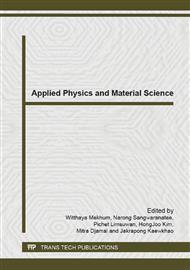p.331
p.335
p.339
p.343
p.347
p.351
p.355
p.359
p.363
Influence of Composition and Isothermal Sintering on the Properties of Hydroxyapatite Bioceramic Bodies
Abstract:
This work reports the influence of chemical composition and sintering schedule on the properties of sintered bodies of hydroxyapatite (HA) bioceramic. The method of preparing sintered bodies by solid state reaction and uniaxial pressing. The raw material used calcium carbonate (CaCO3) and ammonium dihydrogen phosphate (NH4H2PO4) powder as precursors. These powders were mixed at CaCO3: NH4H2PO4 mass ratio of 1:0.697, 1:0.692, 1:0.689, 1:0.685 and 1:0.68, respectively. The compositions in the temperatures range of 800-1300 °C for 3 hour. The sintered bodies were characterized by X-ray diffraction (XRD), scanning electron microscope (SEM), and Fourier transform infrared spectroscopy (FTIR). Properties including phase, microstructures, porosity and bending strength of the samples. The results show that green bodies can be sintered at 1150 °C for 3 hours. This temperature found that crystals growth, highest of HA phase content in sintered bodies, good density and high efficiency strength properties.
Info:
Periodical:
Pages:
347-350
Citation:
Online since:
June 2014
Price:
Сopyright:
© 2014 Trans Tech Publications Ltd. All Rights Reserved
Share:
Citation:


